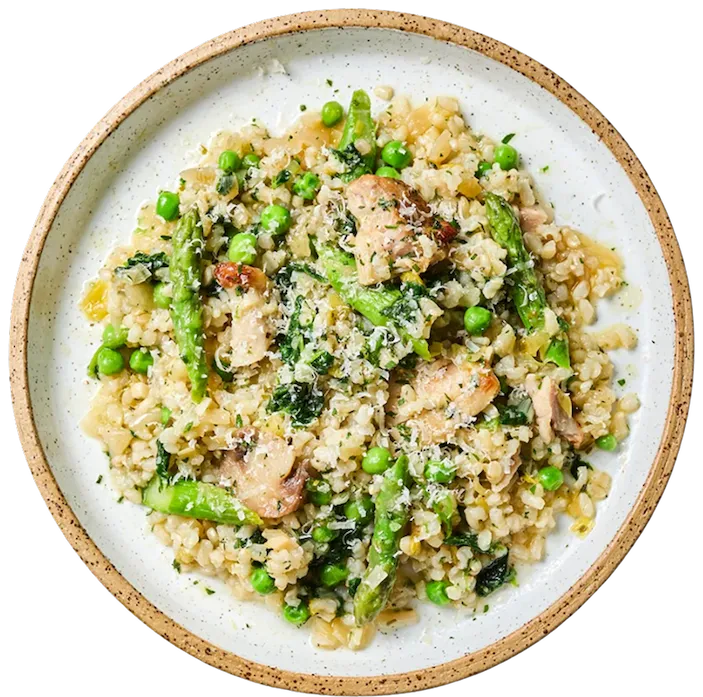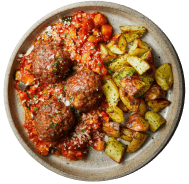Tempeh
Guide To Tempeh: Nutrients, Health Benefits and Cooking Tips
This versatile ingredient forms the backbone for many meat-free meals, being a source of protein alongside many other essential nutrients. learn more about how to incorporate tempeh into your cooking.
Tempeh
Tempeh is a popular choice for vegans and vegetarians as it is a nutrient dense meatless source of protein. Made from fermented soya beans it is packed with vitamins and minerals.
What is Tempeh?
Tempeh is a traditional Indonesian food made from cooked fermented soya beans. The process to make tempeh takes a few days as the soya beans are first soaked overnight and then de-hulled before cooking and cooling. The soya beans are then fermented (broken down by microorganisms) and then pressed into a compact cake form (1).
Interesting facts
Tempeh is also known as tempe and has grown in popularity as more people choose a plant based diet.
Traditionally tempeh is made from soya beans but it may be made from a mixture of soya beans and wheat or wheat. It is a versatile cooking ingredient as it can be cooked in several ways; steamed, sautéed, or baked.
Rich in
- Protein
- Iron
- Calcium
- Riboflavin
- Niacin
- Magnesium
- Phosphorus
- Manganese
- Soy isoflavones
Key health benefits
Good for gut health. As it’s a product of fermentation it is a probiotic food and rich in prebiotics (fibre shown to promote the growth of good bacteria in your gut and reduce inflammation) (2).
Helps control your appetite – Tempeh is a good source of protein which can help you feel fuller for longer, stave off hunger pangs and supports weight loss (3).
Good mineral availability. The fermentation process also breaks down phytic acid, known as an anti-nutrient as it impairs mineral absorption. Theis means that the minerals in the tempeh, such as iron and calcium are more bioavailable and more easily absorbed in your body (6).
Supports bone health. If you are following a vegan diet, tempeh is a good dairy-free source of calcium, manganese and phosphorus. All these minerals support normal bone health and are easily absorbed from tempeh thanks to the fermentation process (7).
Rich in antioxidants. Soya bean isoflavones also act as antioxidants and may reduce free radical activity in your body (8).
Cooking tips (from Matt)
Tempeh is rich, earthy and nutty, although it can tend towards being bitter or bland before cooking for some people. Here are a few tips to prepare and cook tempeh and get the best texture and flavour.
Add coarsely grated or crumbled tempeh to plant-based pasta sauces, stews or chilli's as a great way to give a mince like consistency and to add savoury depth and protein. Tempeh takes on the flavour of other ingredients really well, and it doesn’t need to be restricted to plant-based recipes and is a great way to reduce meat content.
If you find tempeh a bit bitter when cooked from raw then simmer in a saucepan with salted water or stock for about 10 minutes, then drain and move onto slicing, marinating, pan frying or grilling. Slicing thinly about 1/2cm-1cm is a great way to pick up flavours from marinades and improve texture when frying or grilling.
Good tempeh marinade ingredients include soy sauce, vinegars, citrus, nut butters, spices and spice pastes, or sweeteners like brown sugar or honey. Pan fry or grill until the edges turn caramelized and crisp with a slightly chewy interior.
related content
more content: Hero Ingredients
browse our ranges.
choose from one of our ranges or personalise your own menu from 60+ meals.
- low FODMAP

- eat well, live well programme

- gluten free

- high protein

- weight management

- ibs

- lowest calorie

- lower carbs

- mediterranean

- smaller range

- pcos

- lean + lighter

- menopause

- heart healthy

- plans

- full menu

- gift cards
- take the quiz